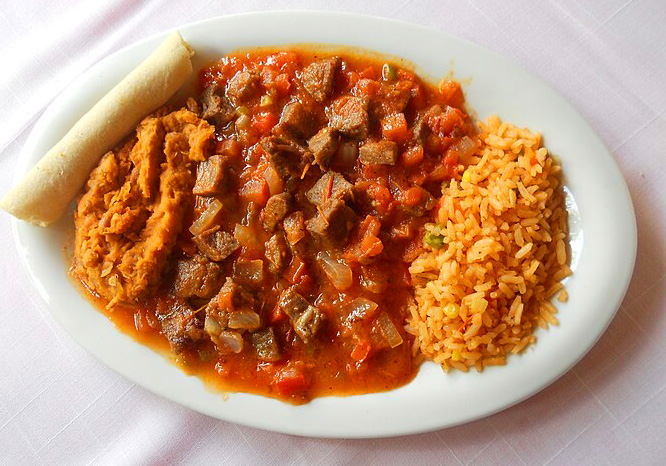NUEVO LEÓN

CULINARY THUMBNAIL
Here are three characteristics of this state's cuisine:
- extensvie orange orchards are found around Montemorelos
- it's cattle country, so there's plenty of meat and dairy products
- much processed food and articles made of wheat flour instead of cornmeal because of its proximity to the USA
TRADITIONAL DISHES TO LOOK FOR
 Cortadillo de res, or "little beef chunks"; copyright-free image from restaurant in Nuevo León, courtesy of "Documentacion Labnl," made available through Wikimedia Commons.
Cortadillo de res, or "little beef chunks"; copyright-free image from restaurant in Nuevo León, courtesy of "Documentacion Labnl," made available through Wikimedia Commons.- Cabrito -- goat prepared prepared in various ways; check out Lonches de Cabrito, Cabrito en Su Sangre and Cabrito al Pastor
- Flor de Palma (in season) -- the words translate to "palm flower" but the flowers are from the Izote yucca, and are presented in a kind of torta made with beaten eggs and tomato sauce
- Asado de Puerco -- roasted pig
- Machaca con huevo -- dried, salted beef that is rehydrated, lightly roasted over fire, soaked in water to remove the salt and to soften, then pounded to pieces, traditionally over a mesquite trunk, by a mesquite pole. Then it's put in water again to get out more salt, and finally squeezed and fried in a skillet. A salsa is made with onion, chili, tomato and oregano, the salsa is mixed into the fried beef and the whole thing is cooked for about five minutes. Most people expect to eat this with wheat tortillas, beans and coffee. This particular machaca also contains eggs
SWEETS
- Cajeta de membrillo and Cajeta de perón -- traditional cajetas are typically gelatin-based deserts congealed in a round box four or five inches across, made of thin wood slivers. Membrillo is quince, and perón is a pearlike fruit
- Gloria -- a nut-based sweet
- Conservas de Naranja -- orange preserves
- Empanadas de calabaza -- a wheat-flour tortilla folded over pumpkin with unrefined brown sugar, then fried in oil
ALCOHOLIC DRINK
- Mescal -- distilled from pulque, which is a mildly intoxicating drink made by fermenting the sap, or aguamiel, of the maguey agave
Information on this page based on material presented in Gastronomía: Atlas cultural de México, 1988, an extensive and well illustrated work by various authors, published by the Secretaría del Educación Pública, Instituto Nacional de Antropología e Historia in Mexico City.